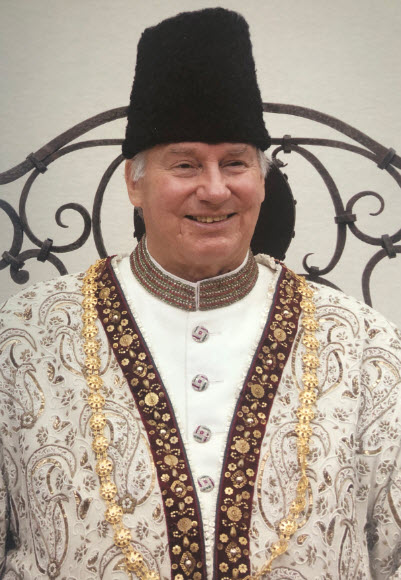O mankind! Verily
There hath come to you
A convincing proof
From your Lord:
For we have sent unto you
A light (that is) manifest (4:174)

The Prophet’s descendant has taken up the seat of his ancestor
in majestic glory, the tip of his crown stretching all the way to Saturn.
The Chosen One is the one whom God has chosen;
what foolishness do you keep babbling on about?
There, where the Prophet sat by God’s command,
His descendant sits today by the same command.
Nasir-i Khusraw, Divan, 232:70-2
Ruby of Badakshan p 141
When the light of the Imam of the time shone upon my soul
Even though I was dark as night, I became the glorious sun
The supreme name is the Imam of the time
By which I ascended, Venus-like, from the earth to heaven.
Nasir-i Khusraw, Divan 139, 341
The Ismailis in the Middle Ages p 135
~*~
The people of
the house of Prophethood
are the manifestations of light.
They are that
which exists forever
and in what has already elapsed.
Shaykh Khudr
Selected verses of “Ships of Salvation”
Shimmering Light p 106
~*~
Aaj raaj mubarak hove
Nur aen Ali ku raaj mubaarak hove
Shah aale Nabi ku raaj mubaarak hove
Congratulations to you today for this (spiritual) kingdom.
O light of the eyes of Hazrat Ali, Congratulations to you for this kingdom,
O Progeny of the Prophet, Congratulations to you for this kingdom.
Munajat – Ya Ali Khub Mijalas Jannt Karke
Munajat is an Arabic word meaning ‘a secret’ or ‘confidential consultation,’ derived from the word najwa. The munajat is a form of prayer in which believers enter into an intimate conversation with their Lord, It is also known as a ‘whispered prayer,’ or a ‘prayer of spiritual longing.’
Secondary Curriculum, Faith and Practices in Islamic Traditions Vol. 2 p 125

In accordance with Shia doctrine, tradition, and interpretation of history, the Holy Prophet [Salla-llahu ‘alayhi wa-sallam] designated and appointed his cousin and son-in-law Hazrat Mawlana Ali Amiru-l-Mu’minin (‘Alayhi-s-salam), to be the first Imam to continue the Ta’wīl and Ta‘līm of Allah’s final message and to guide the murids, and proclaimed that the Imamat should continue by heredity through Hazrat Mawlana Ali (A.S.) and his daughter Hazrat Bibi Fatimat-az-Zahra, Khātun-i-Jannat (‘Alayhi-s-salam).
The Imam’s Talim lights the murids‘ path to spiritual enlightenment and vision.
The Constitution of the Shia Imami Ismaili Muslims
“…today the Ismailis are the only Shia community who, throughout history, have been led by a living, hereditary Imam in direct descent from the Prophet.”
Mawlana Hazar Imam
Ottawa, Canada, February 27, 2014
Speech
“In all interpretations of Islam, Imams, whether they are Shia or Sunni, are required not only to lead in the interpretation of the faith, but equally to contribute to improving the quality of life of the people who refer to them….It is on this ethical premise, which bridges faith and society, that I established the Aga Khan Development Network.”
Mawlana Hazar Imam
Oslo, Norway, April 7, 2005
Speech

“The stars are a pledge to the world that it will not be drowned,
and my family are a pledge to the community that it will not go astray.”
Prophet’s hadith
Cited in Diversity and Pluralism in Islam p 98
Sources:
Alice C. Hunsberger, Nasir Khusraw, The Ruby of Badakhshan, I.B. Tauris in association with The Institute of Ismaili Studies, London 2000
James W. Allan, “Islamic Art and Doctrinal Pluralism,” Diversity and Pluralism in Islam Edited by Zulfikar Hirji, I.B. Taurus Publishers, 2010
Shafique N. Virani, The Ismailis in the Middle Ages, Oxford University Press, 2010
Shimmering Light, An Anthology of Ismaili Poetry tr. Faquir M. Hunzai, I.B. Tauris in association with The Institute of Ismaili Studies, London, 1996
